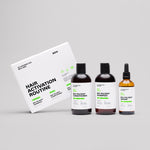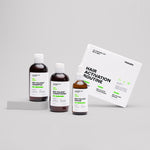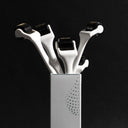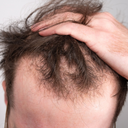Minoxidil, like finasteride, has been shown to increase hair development and may assist men with male pattern hair loss, often referred to as male pattern baldness, in restoring their thinning hair.
However, whether or not Minoxidil works on the hairs around the hairline is a topic of dispute on the internet.
We believe you deserve clarity on this. The last thing you'd need right now is extra stress and hassle.
Minoxidil, primarily a topical minoxidil solution, was studied mainly on the top of the scalp and crown, areas often affected by male pattern baldness, to get FDA clearance. This led to the widespread belief that it only acts on these regions of the hair growth cycle.
In this article, we'll give you clarity on the issue and whether it's a good idea to use minoxidil for your receding hairline.
Table of content
Does minoxidil work for a receding hairline?
In short, yes, Minoxidil has been shown to be effective in treating a receding hairline. It promotes hair regrowth by dilating blood vessels in the scalp and increasing blood flow to hair follicles. However, individual responses may vary, and consulting with a healthcare professional is recommended.
The connection between minoxidil's mechanism and its impact on receding hairlines lies in its ability to improve blood flow. A receding hairline often results from a combination of genetic factors and hormonal changes.
Minoxidil, by increasing blood flow and widening blood vessels around hair follicles, may provide a more conducive environment for hair regrowth. Improved blood circulation can enhance the delivery of nutrients and oxygen to hair follicles, potentially stimulating the growth of finer, vellus hairs and, in some cases, promoting the recovery of thicker terminal hairs along the receding hairline.
As your leading source for hair health information over the past 4 years, we never compromise on accuracy. When it comes to your health, you deserve information you can truly rely on - and earning your trust is our top priority.
Here's how Scandinavian Biolabs ensures every piece of content meets the highest standards of accuracy and integrity:
- Credentialed Experts: Our reviewers are actively practicing doctors and medical researchers
- Stringent Reviews: Content undergoes rigorous editing by subject specialists and review by a practicing doctor.
- Evidence-Based: We rely on well-established research from trusted scientific sources like peer-reviewed journals and health authorities.
- Full Transparency: Our editorial standards, writer credentials, reviewer credentials, correction process, and funding are all publicly documented.
- Independent Voice: While we do promote products, we operate in a vacuum to business operations. Our main goal is just an unwavering commitment to providing medically-sound guidance.
You can count on Scandinavian Biolabs to consistently deliver the trustworthy health information you deserve. Read our Editorial Standards.
How to apply minoxidil for receding hairlines?
Here are the 7 basic steps for applying minoxidil to a receding hairline:
- Make sure your hair and scalp are clean and dry before applying. Wash your hair first if needed.
- Work a small amount of minoxidil between your fingers until fully dissolved. Use just enough to cover the receding hairline area.
- Gently rub the minoxidil into the skin along the receding hairline. Massage it in so it's evenly distributed on the skin.
- Pay extra attention to the temples and corners where hair is receding most. Make sure these areas are fully coated with minoxidil.
- Let the minoxidil fully dry before styling your hair or putting on a hat. This usually takes 15-30 minutes.
- Apply once in the morning and once before bed daily. Consistency is important for best results in regaining hair along the hairline.
- Wash your hands with soap and water after applying minoxidil to avoid transferring it to other areas.
Be patient as it can take 3-6 months to see benefits. Stick with the routine for at least that long to give it the best chance to work. The key is applying a small amount directly to the skin along the receding hairline spots, massage it in well, and be consistent with daily use over several months.
Are there any side effects of using minoxidil?
Minoxidil is commonly used for hair loss, but individual experiences with side effects may vary depending on its form of administration. It's crucial to be informed of these potential side effects before incorporating minoxidil into your routine.
Oral minoxidil side effects:
- Headaches: Some users report experiencing headaches.
- Stomach issues: This can range from nausea to vomiting.
- Skin issues: Including rashes, acne, hair shedding, and hypertrichosis (excessive body hair growth).
- Heart issues: Symptoms might include tachycardia (fast heart rate) and dizziness.
- Fluid retention: Some users might experience swelling due to fluid buildup.
Topical minoxidil side effects:
- Scaling: Appearance of dry, flaky skin.
- Scalp itching: Mild to moderate itching on the scalp.
- Flaking: Dry skin that peels off.
- Dry skin: The scalp may feel parched.
- Burning: A burning sensation on the scalp.
- Irritation: General discomfort or redness on the scalp.
It's worth noting that these side effects are typically mild and often subside over a few weeks. However, if minoxidil gets on other skin areas, it can cause facial or body hair growth. A
lways wash hands thoroughly after application. In rare instances, severe allergic reactions can occur; if you experience any alarming symptoms, seek medical attention immediately.
Is there another option for your receding hairline?
If you are looking for drug-free, guaranteed and nature-based solutions to support your receding hairline, consider our Hair Growth Routine.
We offer a results-based refund policy. If you are not satisfied with the effectiveness of our products, you can request a full refund.
Learn more about our guarantee
Key takeaways
Minoxidil is a popular and successful therapy that is both backed by science and the FDA, whether you're trying to avoid what your genetics are warning you is coming, or you're already in the throes of hair loss.
The specific mechanism of how minoxidil works is not fully understood, but it's thought to possibly enhance blood flow to areas where applied, which may support the hair growth cycle.
If you are unsure about the effectiveness of minoxidil, try out naturally-derived, vegan and cruelty-free hair growth routine from Scandinavian Biolabs. We offer a 150-day results-based refund policy.
Or, check out other alternatives to minoxidil.
FAQs
Does minoxidil work on frontal baldness?
Minoxidil can potentially promote hair growth anywhere on the scalp. However, its effectiveness is generally considered to be lower on the front of the head. That said, there's evidence indicating that 5% topical minoxidil foam might aid hair regrowth in the frontal region.
Can minoxidil fix a bad hairline?
While minoxidil is primarily known for treating vertex hair loss, a study involving 16 men found it similarly effective for receding hairlines. Anecdotal accounts also suggest its usefulness for hairline restoration, indicating that it can potentially help.
What kind of baldness does minoxidil work on?
Minoxidil is primarily used to treat androgenetic alopecia. Additionally, it's employed off-label for various other hair loss conditions.
Is Minoxidil a permanent fix?
Minoxidil can stimulate hair growth and rejuvenate hair follicles, with about 60% effectiveness. However, the results are not permanent.
READ MORE:- Widow’s Peak: Everything You Need to Know
- DHT Blocker Shampoo Side Effects On Male And Female: Full List
- How To Repair Damaged Hair Follicles?
References:
- Chin E. (2013). Androgenetic alopecia (male pattern hair loss) in the United States: What treatments should primary care providers recommend? DOI: 10.1111/1745-7599.12030
- Effectiveness of 5% minoxidil in treating male-pattern hair loss. (2012). ishrs.org/articles/minoxidil-study.htm
- McAndrews P. (n.d.). Women’s hair loss: Treatment. americanhairloss.org/women_hair_loss/treatment.asp
- Molotsky I. (1987). Baldness drug gains support. The New York Times. nytimes.com/1987/03/17/us/baldness-drug-gains-support.html
- Minoxidil topical. (2010). medlineplus.gov/druginfo/meds/a689003.html
- Raja D, et al. The cost effectiveness of topical minoxidil therapy in management of baldness. (2010). print.ispub.com/api/0/ispub-article/7517
- Rogaine label. (2006). accessdata.fda.gov/drugsatfda_docs/label/2006/021812s000LBL.pdf
- Rundegren J. (2004). A one-year observational study with minoxidil 5% solution in Germany: results of independent efficacy evaluation by physicians and patients. DOI: dx.doi.org/10.1016/j.jaad.2003.10.289
- Scow DT, et al. (1999). Medical treatments for balding in men. aafp.org/afp/1999/0415/p2189.html
- Shapiro J. (2003). Safety of topical minoxidil solution: A one-year, prospective, observational study [Abstract]. DOI: 10.1007/s10227-002-0121-6
- Women’s Rogaine label. (2015). accessdata.fda.gov/drugsatfda_docs/label/2015/019501Orig1s029lbl.pdf







